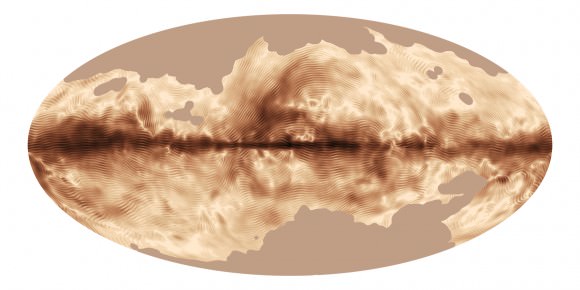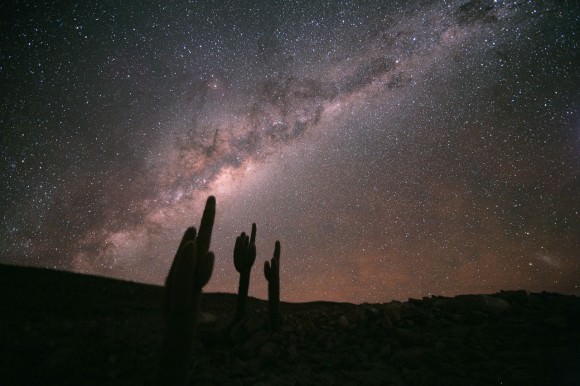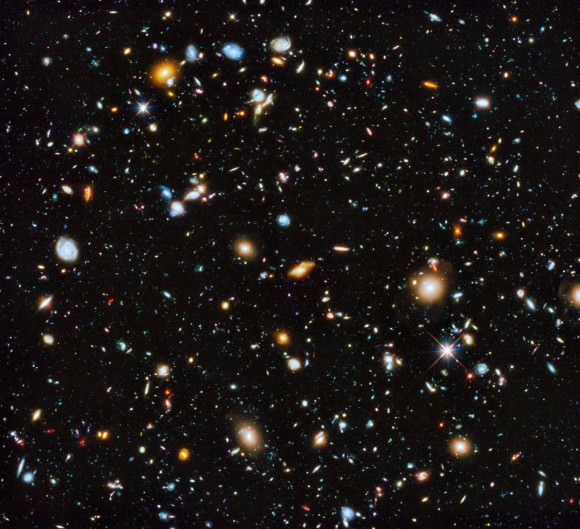We have a lot of crazy informal names for space sights. Sometimes they’re named after how they are shaped, like the Horsehead Nebula. Sometimes they have a name “borrowed” from their constellation, such as the Andromeda Galaxy. But what about our own galaxy, the Milky Way? Why does this band of stars across Earth’s sky have a name associated with food?
First, let’s back up a bit and talk a bit about what the Milky Way actually is. Astronomers believe it is a barred spiral galaxy — a galaxy with a spiral shape that has a line of stars across its middle, as you can see in the picture above. If you were to fly across the galaxy at the speed of light, it would take you an astounding 100,000 years.
The Milky Way is part of a collection of galaxies called the Local Group. We’re on a collision course with the most massive and largest member of that collection, which is the Andromeda Galaxy (also known as M31). The Milky Way is the second-largest galaxy, and the Triangulum Galaxy (M33) the third-largest. There are roughly 30 members of this group all told.
To get a sense of its immense size, you’ll be glad to hear the Earth is nowhere near the Milky Way’s center and its powerful, supermassive black hole. NASA says we’re roughly 165 quadrillion miles from the black hole, which is found in the direction of the constellation Sagittarius.

As for how our galaxy got its name, it is indeed because of its milky appearance as it stretches across the sky. While spotting the galaxy’s arms is a challenge from our current light-polluted centers, if you get out to a more rural area it really begins to dominate the skies. The ancient Romans called our galaxy the Via Lactea, which literally means “The Road of Milk.”
And according to the Astronomy Picture of the Day website, the Greek word for “galaxy” also derives from the word “milk”. It’s hard to say if it was a coincidence, because the origin of both the Milky Way’s name and the Greek word for galaxy are long lost to prehistory, although some sources say that it was inspired by the Milky Way’s appearance.
It took thousands of years for us to understand the nature of what we were looking at. Back in the time of Aristotle, according to the Library of Congress, the Milky Way was believed to be the spot “where the celestial spheres came into contact with the terrestrial spheres.” Without a telescope, it was hard to say much more, but that began to change in the early 1600s.

One important early observation, the library adds, was from the noted astronomer Galileo Galilei. (He’s best known for being credited for the discovery of four of Jupiter’s moons — Io, Europa, Callisto and Ganymede — which he spotted through a telescope.) In his 1610 volume Sidereus Nuncius, Galileo said his observations showed the Milky Way was not a uniform band, but had certain pockets with more star densities.
But the true nature of the galaxy eluded us for some time yet. Other early observations: the stars were a part of our Solar System (Thomas Wainwright, 1750 — a claim that was later shown as erroneous) and that the stars appeared to be denser on one side of the band than the other (William and John Herschel, in the late 1700s).
It took until the 20th century for astronomers to figure out that the Milky Way is just one of a large number of galaxies in the sky. This came, the library says, through a few steps: doing observations of distant “spiral nebulas” that showed their speeds were receding faster than the escape velocity of our own galaxy (Vesto Slipher, 1912); observations that a “nova” (temporary bright star) in Andromeda was fainter than our own galaxy (Herber Curtis, 1917); and most famously, Edwin Hubble’s observations of galaxies showing that they were very far from Earth indeed (1920ish).

There are in fact more galaxies out there than we could have imagined even a century ago. Using the Hubble Space Telescope, periodically astronomers have used the powerful observatory to gaze at a tiny patch of the sky.
This has produced several “deep fields” of galaxies billions of light-years away. It’s hard to estimate just how many there are “out there”, but estimates seem to say there are at least 100 billion galaxies. That’ll keep astronomers busy observing for a while.
We have written many articles about the Milky Way for Universe Today. Here are some facts about the Milky Way, and here’s an article about the stars in the Milky Way. We’ve also recorded an episode of Astronomy Cast about galaxies. Listen here, Episode 97: Galaxies.


“Romans” were right…
Milkyway Galaxy, really, looks like milk spilled on the dusty village road…
The milk were to be carried to processing facilities in the churn on the donkies… If the leather seal was not tight enough, milk was to spill on the road… The dust on the village road was deeper than on Mars…! Spilled milk on the dusty road looked like, almost, Milky Way…!